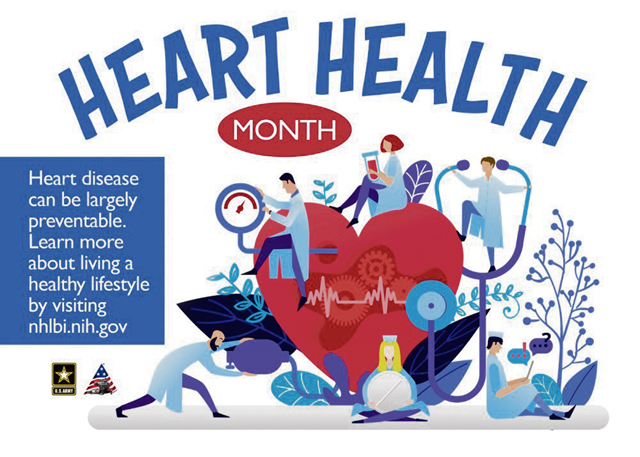 According to studies by the Centers for Disease Control and Prevention, heart disease is the leading cause of death in the United States. About one in four deaths can be attributed to heart disease.
According to studies by the Centers for Disease Control and Prevention, heart disease is the leading cause of death in the United States. About one in four deaths can be attributed to heart disease.
“Women and men experience heart attacks differently,” said Lt. Col. Renee Howell, Army Public Health Nursing Regional Consultant at Public Health Command Europe. “When thinking of a heart attack, chest pain and shortness of breath come to mind but there are additional signs you need to be aware of.”
Men commonly complain about a discomfort or tingling in arms, back, neck, shoulder or jaw. Women, however, tend to exhibit additional symptoms such as nausea or vomiting, unusual tiredness, cold sweat, sudden dizziness and heartburn-like feeling.
“You can greatly reduce your risk for heart disease through lifestyle changes and exercise,” said Howell. “Thirty minutes a day, six days a week of aerobic activity with strength training can reduce your risk immensely.”
Due to the current COVID-19 pandemic, fitness centers across Europe have limited their services or closed entirely, making scheduled exercising a bit more challenging.
“Try to use your car less and walk to places that are reachable by foot. Maybe go for a bike ride or take a hike to stay active,” explains Howell. “Your routine of exercising at the gym may need some modification, but it’s still doable.”
Small changes in your day-to-day routine can become healthy habits. Regular physical activity, picking healthy foods and drinks such as fresh fruits and vegetables and fewer processed foods can help prevent heart disease. PHCE officials also recommend limiting alcohol intake and not smoking. Cigarette smoking greatly increases your risk for heart disease.
According to Howell it is equally important to know your numbers. “Unlike your family history, ethnicity and gender — which cannot be changed — these factors can be altered by the choices you make every day.”
“If you’re numbers are higher, this is not permanent. You can change your health, choose a healthy lifestyle,” said Howell.
There are three measurements that are crucial indicators of your overall health and related to risk for heart attack and stroke.
1. Blood Pressure: Your healthy target: 120/80 mm Hg or less
If it’s too high, your heart must work harder. Over time, high blood pressure can cause the heart to enlarge or weaken. This can lead to heart failure. High blood pressure can also narrow your arteries, which disrupts proper blood flow to your heart or brain and can trigger a heart attack or stroke.
2. Blood Cholesterol: Your healthy target: Total blood cholesterol lower than 200 mg/dL
Too much cholesterol can lead to plaque buildup inside your blood vessels. This sticky substance causes your arteries to harden and narrow, which limits blood flow. These blockages can create a heart attack or, if located in the brain, a stroke.
3. Body Mass Index: Your healthy target: 18.5 to 24.9
Your BMI is a weight-height calculation that can help determine if you’re overweight or obese. Excess body fat increases your risk for a wide range of health problems, including high blood pressure, heart disease and type 2 diabetes.
It is important to know these critical numbers in your life because they will allow you and your healthcare provider to determine your risk for heart diseases.
For more information about Heart Health Month follow “Public Health Command Europe” on Facebook.


